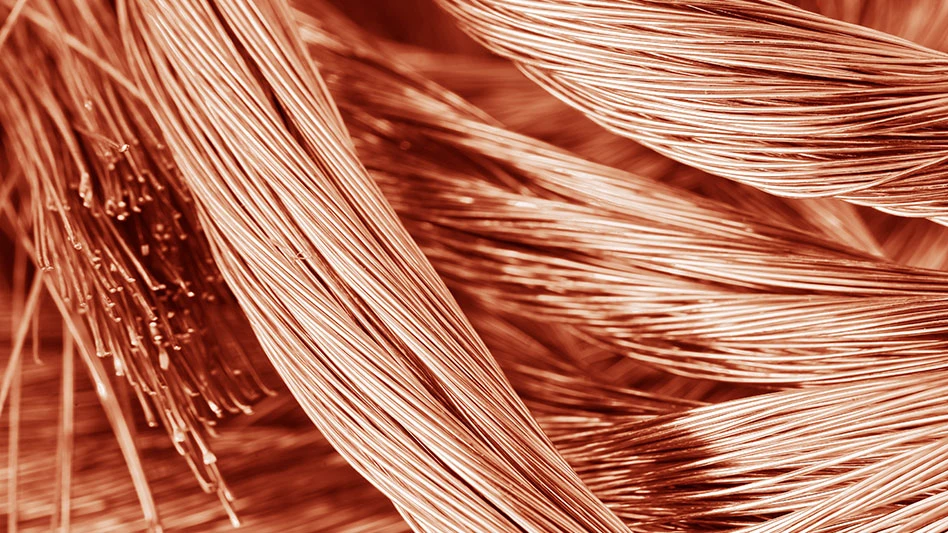
epitavi | stock.adobe.com
President Donald Trump and U.S. Department of Commerce Secretary Howard Lutnick have indicated a 50 percent tariff on imported copper will start Aug. 1, though neither the White House nor the Commerce Department has released additional information as of July 18. Instead, in a televised portion of an early July cabinet meeting, Trump remarked, “Today we're doing copper,” turning to Lutnick for confirmation that the tariff rate will be 50 percent.
The administration launched a Section 232 investigation into copper this February, examining U.S. imports of raw mined copper, copper concentrates, copper alloy, scrap copper and derivative products and whether they threaten U.S. national security and economic stability, with potential trade remedies to be suggested.
Ed Meir of Marex, which is headquartered in London, tells Recycling Today that adding a tariff on copper imports is puzzling given the U.S.’ dependence on imported copper. “Last year, America imported roughly 810,000 tons of cathode, roughly half of what it consumes. A third of these imports came from Chile, a quarter from Canada and the balance mostly from Mexico and Peru.”
In response to the tariff announcement, the spot price of COMEX copper rose by 66 cents, or 13 percent, to end the day at what copper industry analyst John E. Gross, publisher of “The Copper Journal,” calls “a record high close of $5.65” per pound.
When the investigation was announced in February, COMEX copper gained 20 cents per pound.
“Whenever Trump opens his mouth, it moves the commodity markets,” says Joel Fogel, executive vice president of Cohen Recycling in Middletown, Ohio. “What it has done with COMEX is absurd.”
Fogel says 90 percent of the activity on the COMEX is from nonphysical users of the metal who are acting based on speculation. He notes the relative stability of the London Metal Exchange (LME) copper price, saying it’s an indication that the COMEX price is overvalued.
If the tariff is enacted, Fogel says, it could curb cathode coming into the U.S. that is replacing scrap in U.S. melt shops. “Why buy bare bright when you can buy cathode so cheap?”
However, a tariff on incoming cathode would leave those dependent on the material in a bad position. Despite the new secondary copper producers in the U.S. that have opened since 2023 or are in the process of ramping up, none produce cathode. “If you need cathode, you can’t get it here,” Fogel says.
While a tariff on copper cathode imports could open domestic capacity for U.S. scrap suppliers, he says, spreads have been widening like never before because the COMEX price is “based on an inflated market that just doesn’t make sense because it doesn’t match the physical market.”
In the fourth quarter of last year, Cohen Recycling changed its approach to hedging its copper inventory given the widening discrepancy between the LME and COMEX prices. The company now uses the LME price rather than COMEX in its hedging. “We would be completely upside down today hedging with COMEX.”
In the aluminum sector, as the Midwest Premium has increased, spreads have widened somewhat.
Fogel describes domestic demand for recovered aluminum as being OK, adding that it’s difficult to sell recovered aluminum on a spot basis. “That can’t be said on the copper side.”
Fogel says export demand for red metal scrap remains strong, particularly from Europe, as well.
“We’ve been dealing with volatility in copper for the last several years, but this is historic and unheard of,” he says, referring to the COMEX price runup as being “knee-jerk reactions to what is going on politically, socially and economically. So much is driving markets outside of our control."
“We can’t control the sale price; that’s a function of the market," he adds. "We can somewhat control the purchase price. We set budgets and control costs as best as we can.”
In his July 8 edition of “The Copper Journal,” Gross writes, “It is imperative that the administration lay out the details of how tariffs will be imposed and also announce the results of their investigation into imports of copper as they relate to national security. Until this is done, the global copper market will remain dangerously volatile.”
Latest from Recycling Today
- Phoenix Technologies closes Ohio rPET facility
- EPA selects 2 governments in Pennsylvania to receive recycling, waste grants
- NWRA Florida Chapter announces 2025 Legislative Champion Awards
- Goldman Sachs Research: Copper prices to decline in 2026
- Tomra opens London RVM showroom
- Ball Corp. makes European investment
- Harbor Logistics adds business development executive
- Emerald Packaging replaces more than 1M pounds of virgin plastic





